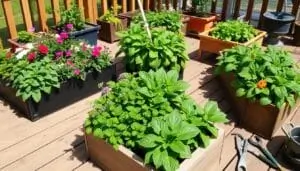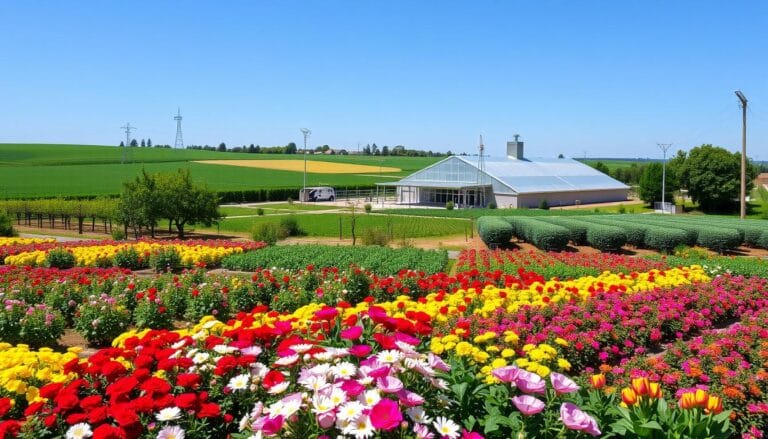What is the role of kinship and tradition in horticulture?

As a lifelong gardener, I’ve learned how family, culture, and plants are deeply connected. Kinship and tradition in horticulture are more than just growing food and flowers. They are about keeping a living legacy that connects us to our ancestors and nature. When I first visited my grandmother’s garden, I felt a deep sense of belonging. It was as if the plants were welcoming me into a special, ancestral space.
Family knowledge and practices shape our view of the world and our place in it. In many cultures, plants are seen as living beings with feelings and connections to us. This view teaches us to respect nature’s cycles and our role in keeping the ecosystem balanced.
Exploring kinship and tradition in horticulture reveals a rich tapestry of stories and rituals. These practices, like naming plant relatives and special cultivation techniques, connect us to our history and identity. By keeping and sharing this knowledge, we ensure horticulture’s traditions continue to thrive. This connects us to a long line of earth stewards.
Table of Contents
Understanding Familial Bonds in Plant Cultivation
In horticulture, kinship and tradition are key. Family has been involved in growing plants for centuries. This has shaped horticulture worldwide. Family members share cultural heritage and ecological knowledge through plants.
Cultural Heritage in Growing Practices
Family life and horticulture are closely linked. Lessons on plants often happen at home or in community spaces. Each generation adds their own insights, preserving traditional methods.
Intergenerational Knowledge Transfer
Passing down kinship systems in gardening goes beyond just growing plants. Elders teach younger ones about the land and seasons. This builds a deep connection between people and plants.
Family-Based Agricultural Systems
In traditional societies, family-based growing systems are crucial. They involve many generations working together. This approach keeps traditions alive and strengthens family bonds.
“The richest memories of family are often associated with the cultivation of herbs, vegetables, and ornamental plants, as each generation imparts their unique insights and techniques.”
Historical Evolution of Horticultural Family Practices
Horticulture started in the Middle East about 9,500 years ago. It spread to North China, Mexico, and Peru over 4,500 years. In tropical areas, horticulture based on tropical crops came later.
New tools changed how people grew plants. Moving from stone axes to steel axes was a big step. Animal husbandry also influenced horticulture in some places.
The shift from foraging to horticulture and agriculture was key. It led to more people, complex societies, and new jobs. This change is called the Neolithic Revolution.
Carl Linnaeus introduced a system to name plants in the 18th century. This helped us understand plant diversity better. Botanists like Augustin Pyramus de Candolle looked at more features to classify plants.
Family traditions and kinship roles in plant cultivation have shaped human societies. Knowing about family traditions in horticulture helps us keep our cultural heritage alive.
“The adoption of agriculture allowed for population growth, the development of complex social structures, and the emergence of specialized roles and occupations.”
Role in Kinship in Horticulture
In horticultural communities, kinship is key. It shapes how people grow plants, make decisions, and share resources and knowledge. Family ties are what make these agricultural societies strong.
Family Structure Impact on Growing Methods
Family shapes how labor is organized and horticultural skills are passed down. In kinship groups, each generation brings its own expertise. This intergenerational knowledge transfer keeps horticulture alive and evolving.
Communal Decision Making
Decisions in horticultural communities are made together. Everyone in the family group has a say. This way, many ideas are heard and used, thanks to kinship structures in horticulture communities.
Shared Resources and Knowledge
Sharing is a big part of horticultural societies. They exchange tools, information, and help. This makes sure resources are used well and horticulture keeps getting better. It also builds a strong sense of community.
Looking into kinship in horticulture helps us understand these societies better. We see how social and cultural ties shape these vibrant agricultural systems.
Traditional Ecological Knowledge Systems
Kinship and family ties play a big role in horticulture. In many traditional societies, knowing the land and its ecosystems is key. This knowledge shows how people, plants, and the environment are connected.
In these communities, horticulture is more than just growing plants. It involves understanding the local environment, managing land, and using plant medicines. This knowledge is passed down through generations, with each family member contributing to it.
The language and traditions of these societies reflect their environment. This shows how human actions affect the whole ecosystem. Traditional ecological knowledge emphasizes the connection between all living things, guiding how these communities grow plants and manage resources.
“Indigenous people protect 80 percent of the remaining biodiversity on the planet, despite constituting just four percent of the global population.”
By valuing kinship and family in horticulture, these societies show great respect for nature. Their practices not only preserve cultural heritage but also help manage natural resources sustainably. They offer valuable lessons for today’s plant cultivation and environmental care.

Multi-Generational Plant Knowledge Transfer
Passing down plant knowledge is key in horticulture. Oral traditions help share important info on plant uses and growing methods. Families learn together, like working in gardens or making traditional foods. This keeps ancient growing techniques alive for future generations.
Oral Traditions in Horticulture
Oral traditions are vital for sharing horticulture knowledge. Stories, songs, and legends teach about plants and their cultural values. These stories are a living link to horticulture and family ties across generations.
Teaching Methods Within Families
Families have special ways to teach horticulture. Kids learn by helping in the garden, getting real experience with plants. This hands-on learning builds a strong connection to nature.
Preserving Ancient Growing Techniques
Keeping ancient growing methods alive is crucial. Families protect these traditions, like saving seeds and using natural pest control. By sharing this knowledge, they keep horticulture and family ties strong, preserving cultural heritage.
“The intergenerational transfer of horticultural knowledge is the lifeblood of our cultural identity. It is through these familial bonds that we ensure the survival of our most precious traditions.”
Cultural Significance of Plant Relationships
In horticultural societies, humans and plants have a deep bond. Plants are seen as part of our culture, with special meanings. This view makes us care for and protect plants more.
People often call plants their relatives. This idea makes us treat plants with respect and care. It’s about nurturing them like family.

Getting closer to plants can change how we see them. Watching plants in nature, going on herbal walks, and meditating with plants helps us connect. It makes us appreciate plants more.
Adding cultural traditions to gardening strengthens our bond with plants. Celebrating planting and harvesting, learning plant stories, and gardening together keeps plant traditions alive. It honors our connection with plants.
Valuing plant relationships helps us respect nature more. It leads to better gardening practices. This way, we learn to care for the plants we depend on.
| Activity | Benefit |
|---|---|
| Observing plants in their natural habitats | Increases knowledge and appreciation |
| Mindful gardening | Contributes to building relationships with plants |
| Guided herbal walks or ethical foraging | Strengthens relationships with plants in their natural settings |
| Plant meditation | Enhances intuitive understanding and emotional connections |
| Journaling or artistic expression | Documents and celebrates one’s journey with plants |
| Engaging all senses with plants | Deepens understanding and appreciation |
“The more clearly we can focus our attention on the wonders and realities of the universe about us, the less taste we shall have for destruction.” – Rachel Carson
Family-Based Horticultural Management Systems
In many horticultural communities, family ties are key to garden and farm management. These family involvement in horticulture systems have complex labor, planning, and resource sharing. These methods have been passed down for generations.
Division of Labor in Family Gardens
In family gardens, tasks are often divided based on gender and age. For example, seed selection, planting, weeding, and harvesting are given to specific family members. This ensures the garden runs smoothly.
Seasonal Planning and Coordination
For kinship structures in horticulture communities to thrive, planning is crucial. Family members work together to plan crop rotation, planting, and harvest times. This maximizes the growing season’s potential.
Resource Distribution Methods
Family and community networks have developed detailed ways to share resources like land, tools, and knowledge. This efficient use of resources helps sustain horticultural practices over time.
These family involvement in horticulture systems use each family member’s strengths. This approach creates a balanced and enduring way to grow plants. It keeps traditional kinship structures in horticulture communities alive and strengthens the bond between people and the land.
Modern Applications of Traditional Family Growing Methods
Kinship and passing down knowledge in horticulture are still key today. Many gardeners and small farmers are going back to old family ways. They see the value in sustainable farming. By mixing old wisdom with new science, new farming methods have come to life.
Family horticulture is also used in city gardens and local food programs. It helps people connect with their food. This not only boosts self-sufficiency and food safety but also keeps cultural traditions alive and strengthens community ties.
- Traditional Maasai pastoralists in East Africa exemplify pastoralism, relying on their cattle for cultural identity and economic stability.
- Foraging societies often have flexible social structures with egalitarian decision-making processes, low population density, and minimal material possessions.
- The San people of the Kalahari Desert traditionally rely on a variety of wild plants and animals, showcasing foraging practices.
| Subsistence Practice | Cultural Significance | Sustainability Impact |
|---|---|---|
| Pastoralism | Maasai identity and economic stability | Adaptable to environmental changes |
| Foraging | Egalitarian decision-making, low population density | Reliance on diverse, renewable resources |
| Horticulture | Community-based farming, shared responsibilities | Sustainable soil management, biodiversity preservation |
By keeping and updating traditional family growing ways, modern horticulture gains a lot. It gets the role in kinship in horticulture and intergenerational knowledge transfer in horticulture. This leads to farming that is good for the planet and the community.
Preserving Cultural Heritage Through Plant Cultivation
Plant cultivation is a key way to keep cultural heritage alive. It helps maintain horticulture and family ties in many societies. This effort keeps cultural knowledge alive and strengthens community bonds.
Botanical gardens, seed banks, and cultural education programs are crucial. They document and keep alive the family traditions in horticulture of diverse communities. These efforts protect endangered plants and preserve traditional ecological knowledge.
The Sacred Plant Biocultural Recovery Initiative works to protect sacred plants worldwide. Plants like the cedars of Lebanon and saguaro cactus fruit are valued for their cultural significance. This program highlights the importance of plant cultivation and preservation.
“The sacredness of a plant is based on our relationship to it, rather than inherent genetic qualities.”
Efforts to protect sacred plants are rooted in spiritual beliefs. This is seen in Southeast Asia, China, and other regions. These community-driven efforts are vital in today’s fast-changing world.
Preserving traditional horticulture and family ties safeguards cultural diversity. It also deepens our understanding of humanity’s connection to nature. Through these efforts, we ensure that family traditions in horticulture continue to enrich our lives and unite us globally.
Conclusion
The role of kinship and tradition in horticulture is complex and very important. It involves sharing ecological knowledge, shaping cultural identity, and keeping sustainable farming alive. As we face big challenges like climate change and losing biodiversity, traditional horticulture’s wisdom is more valuable than ever.
Familial bonds in horticulture show us the strong connections in growing plants. The passing down of knowledge from one generation to the next keeps old farming ways alive. This knowledge can help make modern horticulture better, leading to stronger and more diverse food systems.
As we move forward in the 21st century, valuing family and community in horticulture is key. By honoring these traditions, we can find new ways to grow food that are good for the planet and our culture. This approach could lead to a brighter, fairer future for everyone.
FAQ
What is the role of kinship and tradition in horticulture?
How do familial bonds influence plant cultivation?
What is the historical evolution of horticultural family practices?
How does kinship influence horticultural societies?
What is the role of traditional ecological knowledge in horticulture?
How is multi-generational plant knowledge transferred in horticultural traditions?
What is the cultural significance of plant relationships in horticultural societies?
How are family-based horticultural management systems organized?
How are traditional family growing methods being applied in modern horticulture?
How does plant cultivation help preserve cultural heritage?
Source Links
- Herbalism with Kids: 5 Ways to Cultivate a Kinship with Plants • RUN WILD MY CHILD – https://runwildmychild.com/herbalism-with-kids/
- Unraveling the diversity and cultural heritage of fruit crops through paleogenomics – https://pmc.ncbi.nlm.nih.gov/articles/PMC11079635/
- The Birth of the Eastern Agricultural Complex – https://poorprolesalmanac.substack.com/p/the-birth-of-the-eastern-agricultural
- PDF – https://www.iup.edu/ages/files/anthropology/research/oer10.pdf
- Modes of Subsistence – (Intro to Anthropology) – Vocab, Definition, Explanations | Fiveable – https://fiveable.me/key-terms/intro-anthropology/modes-subsistence
- Botanical chronicles: Part 2- All about families – Country Home & Blooms – https://countryhomeandblooms.com/botanical-chronicles-part-2-all-about-families/
- Chapter 16: Subsistence and Political Systems – https://viva.pressbooks.pub/introtoanthropology4field/chapter/__unknown__-5/
- WikiFreedom – Your AI-Powered Encyclopedia of Unbounded Knowledge – https://www.freedomgpt.com/wiki/indigenous-peoples-roles
- Simple Horticultural Societies: Rise & Key Features – https://bcubedpress.com/simple-horticultural-societies/
- Traditional Ecological Knowledge in the Preschool Classroom: An Interview with Nichole Efird – https://rethinkingschools.org/articles/traditional-ecological-knowledge-in-the-preschool-classroom-an-interview-with-nichole-efird/
- Exploring Indigenous Beliefs About Trees and Their Connection to Them — An Darach Forest Therapy – https://silvotherapy.co.uk/articles/exploring-indigenous-beliefs-about-trees
- Relational Transilience in the Garden: Plant–Human Encounters in More-than-Human Life Narratives – https://www.degruyter.com/document/doi/10.1515/culture-2024-0031/html
- Can family structure and contact with natural resources influence young people’s knowledge about medicinal plants? An approach in the Northeast of Brazil – Journal of Ethnobiology and Ethnomedicine – https://ethnobiomed.biomedcentral.com/articles/10.1186/s13002-024-00728-2
- The Magic of Reciprocal Relationships with Plants in Herbalism – https://www.outdoorapothecary.com/reciprocal-relationships-with-plants/
- What’s In a Name? Plant Naming as Cultural Artifact and Story in the Midwestern United States – https://scholarworks.bellarmine.edu/cgi/viewcontent.cgi?article=1182&context=ugrad_theses
- Cross-cousin marriage among Tsimane forager–horticulturalists during demographic transition and market integration – https://pmc.ncbi.nlm.nih.gov/articles/PMC10988167/
- Subsistence Patterns: Types & Examples – https://www.vaia.com/en-us/explanations/anthropology/economic-anthropology/subsistence-patterns/
- Season II Episode 10 – Uplifting Tribal Youth Through Community Gardening – https://cfhlstatewidetraining.org/podcast/season-ii-episode-10-uplifting-tribal-youth-through-community-gardening
- Community Garden Leader’s Tour: Fostering Connection, Sharing, and Place-Based Leadership – https://placerrcd.org/placer-county-community-garden-leader-tour-fostering-connection-sharing-and-place-based-leadership/
- The Sacred Plant Biocultural Recovery Initiative: An Interview with Gary Paul Nabhan – https://www.garynabhan.com/news/2024/06/the-sacred-plant-biocultural-recovery-initiative-an-interview-with-gary-paul-nabhan/
- Advances in the Protection of New Varieties of Horticultural Crops in China – Horticulture Advances – https://link.springer.com/article/10.1007/s44281-024-00048-1
- Genetic architecture and genomic prediction of plant height-related traits in chrysanthemum – https://pmc.ncbi.nlm.nih.gov/articles/PMC10782495/
- Broad-Sense Heritability for Horticultural Production Traits in Eggplant – https://cbgg.hapres.com/htmls/CBGG_1534_Detail.html
Horticulture: A Diverse Field
This is a document about horticulture [1]. It discusses the different lines of horticulture, which is the art and science of growing plants [1]. Horticulture includes growing fruits, vegetables, flowers, and ornamental plants [1]. It is a wide field with many categories [1]. Horticulture is important for food, the environment, and beauty [1]. It offers many paths, from growing food to creating stunning landscapes [1].






